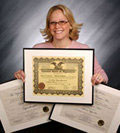Click to go to the video version of this page, The Secret Language of Feelings
Introduction to The Secret Language of Feelings Book
Hello, everybody. I'm Cal Banyan, professional hypnotist. You know, one of my areas of expertise is doing hypnotic age regression, and a specific kind of hypnotic age regression called affect bridge. And basically, what that means is using emotions that are associated with the problem to uncover the cause of the problem, and then using that ability go back and find the cause of the problem, and then neutralizing it. And I've literally done thousands and thousands of those kinds of hypnosis sessions. And as a result, I started understanding what I have come to call the secret language of feelings. And as I got to understand this information, I started explaining it to my clients, and then eventually teaching it in my hypnosis certification courses.
One of my graduates, who is also a friend of mine, who is also a psychologist and teaches counseling at a college, she started teaching my material that I was teaching in class about the secret language of feelings to her students, because she thought it was so important. One day, she called me and says, "Cal, you know what I'd really like you to do is to put together a textbook." And I thought, boy, textbooks are so boring. And then I thought about it, and thought about it, and I thought, you know what I'm going to do, is I'm going to write a book for everyone. And the secret language of feelings really lets you understand why people do what they do. It's going to lead you to a level of emotional mastery that very few people ever reach. Let me tell you what we're going to do in this book is we're going to teach you the cause of emotions and how to respond to them in a satisfying way.
Now, this is the big difference. Most people, what they learn to do in life with emotions is to ignore them, to pretend they're not there, and most importantly, I think, is to distract themselves from the emotion. People develop a feeling inside them that they don't like. It might be fear or anger or guilt, frustration or might feel depressed. And what they do, because in our society, we really have not learned how to respond to feelings in a productive or satisfying way, we simply learn to distract by eating too much, drinking too much, shopping too much, and all those too much behaviors.
In this book, I identify not only how that develops and how society kind of perpetuates that, but I teach you how to first identify the emotion and then respond to it in a satisfying way. Instead of feeling bad and eating too much, or feeling too bad and drinking too much, or feeling too bad and having to have a cigarette, there are some satisfying things that you can do. And the difference between distracting yourself and satisfying yourself is that when you distract yourself from an emotion, as soon as you get done with the distractor, as soon as you get done eating or drinking or smoking or shopping or whatever it is, the feeling comes back into your awareness, and it motivates you to do the distracting behavior again. That's why people eat too much, drink too much, smoke too much, and all those other too much behaviors. When we learn how to satisfy the feeling, what happens is we begin to live a more satisfying life. And the urge to do the too much behaviors fades away. So you're going to learn how to respond to anger in a satisfying and productive and rational way. Sadness. Loneliness. Frustration. Guilt and Anxiety, all those kinds of things.
Now, if you are a helping professional, such as a counselor, psychologist, hypnotist, and so on, social worker, you're going to love this book, because it's really going to give you a way to work with your clients in a way that's so productive. And it doesn't matter if you're a hypnotist, or if you're a behavioral, or if you're cognitive. You're going to see this as a very important addition to your skill set and your library. You don't have to have a PhD to be able to read and enjoy this. I have people with eighth grade education say, "Thank you so much for this book. I read it. It's changed my life."
Okay, that's it. Get the book, add it to your library, add The Secret Language of Feelings to your skill set. You're going to be glad you did. And if you have clients, they're going to be glad you did. As a matter of fact, they're probably going to want the book, too. Okay, that's it. As always, Cal Banyan signing off.
Copyright 2013 Calvin D. Banyan . All rights reserved.
Click to go to the video version of this page, The Secret Language of Feelings



